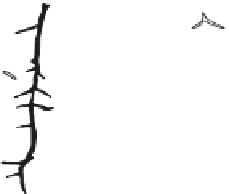Environmental Engineering Reference
In-Depth Information
oversteepened slopes along unstable margins (
Bromley and Ekdale, 1987;
Bromley et al., 1975; Ekdale et al., 2012; Nygaard, 1983
). In many cases, ich-
nofabrics in allochthonous chalk beds simply reflect shearing and truncation of
trace-fossil assemblages emplaced prior to sediment remobilization, and these
assemblages may be representative of any of the ichnofacies described
above (
Bromley and Ekdale, 1987
). However, some of these beds also may
contain, in their upper parts, trace-fossil assemblages emplaced after ooze
remobilization. Typified by
Zoophycos
,
Chondrites
, and/or
Trichichnus
, these
assemblages resemble
Zoophycos
Ichnofacies suites in deep-sea or oxygen-
deficient basin chalks (
Ekdale et al., 1984b
;
Fig. 10
A). Multiple, stacked
allochthonous chalk beds may be penetrated by narrow, vertically extensive
(up to 9 m long), sparsely branched structures that commonly are encased
in cylindrical flint nodules. Referred to as
Bathichnus
, these unusually large
enigmatic structures have been interpreted as combined feeding-dwelling-
escape structures of unknown but long-lived organisms (
Bromley et al.,
1975
). Notably,
Bathichnus
also is recognized in some pelagic successions
(
Table 1
) and, thus, is not necessarily diagnostic of allochthonous chalk
deposits.
A
B
T
d
-T
e
Zo
Ch
Ch
Pl
An
Te
T
b
-T
c
Phy
Th
“Bathichnus”
T
a
Te
Th
FIGURE 10
Trace-fossil associations in redeposited chalks. (A) Ichnofabrics observed in Euro-
pean chalks deposited by ooze flows or debris flows. The tops of the depositional units may be
marked by normal softground trace fossils, most commonly
Chondrites
(Ch) and
Zoophycos
(Zo), while multiple units may be penetrated by vertically extensive, enigmatic structures referred
to as
Bathichnus
(see text). The latter structures may be encased in cylindrical flint nodules (not
shown). (B) Ichnofabric in a calciturbidite based on observations by
Miller et al. (2004)
from the
Cretaceous Scaglia Rossa of Italy. Unlike siliciclastic turbidites, which are typified by the
Nereites
Ichnofacies, calciturbidites commonly lack pre-depositional traces on their soles, and post-
depositional traces are commonly enigmatic. In this example, distinct trace fossils in the middle part
of the calciturbidite (divisions T
b
and T
c
) include compound
Thalassinoides
(Th)—
Phycodes
(Phy)—
Teichichnus
(Te)—
Ancorichnus
? (An) that may have been produced by crustaceans
transported by associated turbidity currents. Trace fossils in turbidite divisions T
d
and T
e
include
Planolites
(Pl) and
Chondrites
(Ch).





























































































































Search WWH ::

Custom Search